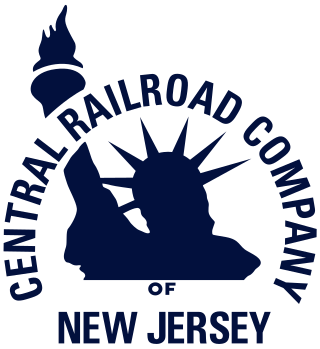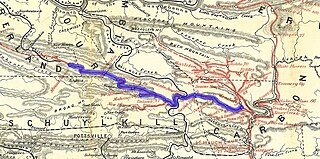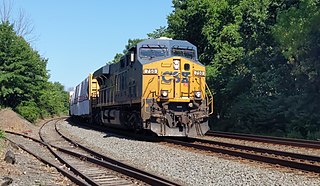Related Research Articles

The New York Central Railroad was a railroad primarily operating in the Great Lakes and Mid-Atlantic regions of the United States. The railroad primarily connected greater New York and Boston in the east with Chicago and St. Louis in the Midwest, along with the intermediate cities of Albany, Buffalo, Cleveland, Cincinnati, Detroit, Rochester and Syracuse. New York Central was headquartered in New York City's New York Central Building, adjacent to its largest station, Grand Central Terminal.

The Delaware, Lackawanna and Western Railroad, also known as the DL&W or Lackawanna Railroad, was a U.S. Class 1 railroad that connected Buffalo, New York, and Hoboken, New Jersey, and by ferry with New York City, a distance of 395 miles (636 km). Incorporated in Pennsylvania in 1853 primarily for the purpose of providing a connection between the anthracite coal fields of Pennsylvania's Coal Region and the large markets for coal in New York City. The railroad gradually expanded both East and West, eventually linking Buffalo with New York City.
The Lehigh Valley Railroad was a railroad built in the Northeastern United States to haul anthracite coal from the Coal Region in Pennsylvania. The railroad was authorized on April 21, 1846, for freight and transportation of passengers, goods, wares, merchandise, and minerals in Pennsylvania and the railroad was incorporated and established on September 20, 1847, as the Delaware, Lehigh, Schuylkill and Susquehanna Railroad Company.

The Central Railroad of New Jersey, also known as the Jersey Central, Jersey Central Lines or New Jersey Central, was a Class I railroad with origins in the 1830s. It was absorbed into Conrail in April 1976 along with several other prominent bankrupt railroads of the Northeastern United States.

The Lehigh and Hudson River Railway (L&HR) was the smallest of the six railroads that were merged into Conrail in 1976. It was a bridge line running northeast–southwest across northwestern New Jersey, connecting the line to the Poughkeepsie Bridge at Maybrook, New York with Easton, Pennsylvania, where it interchanged with various other companies.

The Lehigh and Mahanoy Railroad, originally the Quakake Railroad, was a rail line connecting Black Creek Junction, in the Lehigh Valley, with Quakake, Delano, and Mount Carmel. Opened from Black Creek Junction to Quakake in 1858 and to Mount Carmel in 1860, it allowed anthracite coal mined along the line and bridge traffic to move east towards New York City. After 1866, it was merged into the Lehigh Valley Railroad to become its Mahanoy Branch.
The Lehigh and New England Railroad was a Class I railroad located in Northeastern United States that acted as a bridge line. It was the second notable U.S. railroad to file for abandonment in its entirety after the New York, Ontario and Western Railway. It was headquartered in Philadelphia.
The Terminal Railway of Buffalo was a part of the New York Central Railroad system southeast of Buffalo, New York. It built the Gardenville Branch or Gardenville Cutoff, allowing through trains to bypass Buffalo. The cutoff has since been abandoned in favor of other parallel lines.

The Finger Lakes Railway is a Class III railroad in the Finger Lakes region of New York. The company began operations on July 23, 1995, and operates in Onondaga, Cayuga, Seneca, Ontario, Schuyler and Yates counties. The FGLK operates 18 diesel locomotives on 167 miles (269 km) of ex-Conrail trackage, formerly owned by the New York Central Railroad, the Pennsylvania Railroad and the Lehigh Valley Railroad. Between 2001 and 2013, the railroad operated a heritage railroad known as the Finger Lakes Scenic Railway which offered passenger train excursions.

The Conrail Lehigh Line is a railroad line in New Jersey that is part of Conrail Shared Assets Operations under the North Jersey Shared Assets Area division. The line runs from CP Port Reading Junction in Manville to Oak Island Yard in Newark. The line is double-track and signaled through its entire length. The line began operations in 1999 using former existing tracks from Manville to Newark that was once part of the original Lehigh Line which is still in existence and is owned and operated by Norfolk Southern Railway.
This is a list of trails in Ithaca, New York.

The New York, Auburn and Lansing Railroad, also known as the Ithaca-Auburn Short Line, was the only interurban line to operate in Tompkins County, New York.
The Allentown Railroad was a railway company in the United States. It was incorporated in 1853 with the original intention to connect the Central Railroad of New Jersey at Allentown with the Pennsylvania Railroad's main line across the Allegheny Mountains. Though grading was almost entirely finished, the project was halted by the Panic of 1857, and the completion of the East Pennsylvania Railroad in 1859 made the Allentown Railroad's proposed line largely redundant. As a result, track was never laid on most of the line. The small portion that did became the Allentown branch of the Reading Company from Topton to Kutztown, and was nominally owned by the Allentown Railroad until the Reading dissolved it in 1945 to simplify corporate bookkeeping. Other Reading subsidiaries also laid track on parts of the right-of-way elsewhere along the route. The short line Allentown & Auburn Railroad continues to operate freight service on the Topton to Kutztown route.

The Lehigh Line is a railroad line in Central New Jersey, Northeastern Pennsylvania, and the Lehigh Valley region of eastern Pennsylvania. It is owned and operated by the Norfolk Southern Railway. The line runs west from the vicinity of the Port of New York and New Jersey in Manville, New Jersey via Conrail's Lehigh Line to the southern end of Wyoming Valley's Coal Region in Lehigh Township, Pennsylvania.

Flemington Junction station is a defunct Lehigh Valley Railroad station in Flemington Junction, New Jersey. It was located at the junction of the Lehigh Valley's Flemington Branch and Main Line, although the name predated the opening of the branch by eight years.
The Elmira, Cortland and Northern Railroad was a railroad in the state of New York, in the United States. Its main line ran from Elmira, New York, to Camden, New York. It was formed in 1884 from the consolidation of other railroads and merged into the Lehigh Valley Railroad in 1905. Under the Lehigh Valley, it was known as the Elmira and Cortland Branch. Almost all of its former line has since been abandoned.

Cortland station is a defunct Lehigh Valley Railroad station in Cortland, New York. It was located on the Lehigh Valley's Elmira and Cortland Branch. The station building still stands; the tracks are owned by the New York, Susquehanna and Western Railway. Cortland was one of two depots; the Delaware, Lackawanna and Western Railroad (Lackawanna) depot was located on Railroad Street in the center of the city.
The Southern Central Railroad is a defunct railroad which operated in the state of New York in the nineteenth century. The company's line ran from Fair Haven, New York, on the south shore of Lake Ontario, to Athens, Pennsylvania, in the Southern Tier and just over the border into Pennsylvania. The company was incorporated in 1865 and became part of the Lehigh Valley Railroad system in 1895. Most of its line was abandoned by the Lehigh Valley Railroad between 1937–1979; the portion between Harford Mills, New York, and Owego, New York, is owned by the Tioga County Industrial Development Agency and operated by the Owego and Harford Railway.
References
- ↑ Trice 2004, p. 38.
- ↑ Trice 2004, pp. 39–40.
- Trice, Herbert V. (2004). Marchan, John (ed.). The Gangly Country Cousin. Ithaca, New York: De Witt Historical Society of Tompkins County. ISBN 0-942690-48-6.